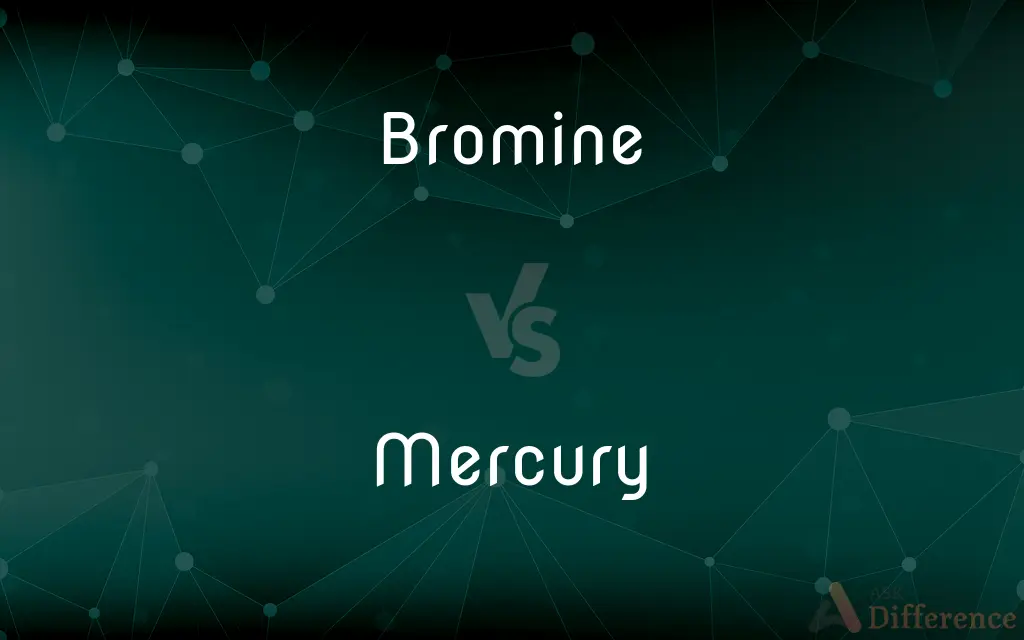Bromine vs. Mercury — What's the Difference?
By Tayyaba Rehman & Urooj Arif — Updated on April 17, 2024
Bromine is a heavy, reddish-brown liquid that vaporizes easily at room temperature, primarily used in chemical synthesis and flame retardants, whereas mercury is a silvery liquid metal used in thermometers and electrical switches, noted for its toxicity.

Difference Between Bromine and Mercury
Table of Contents
ADVERTISEMENT
Key Differences
Bromine is a nonmetallic liquid at room temperature and part of the halogen group, known for its strong, suffocating odor and is used mainly in industrial applications like flame retardants and pesticides, whereas mercury is a metallic element, liquid at room temperature, and used in various devices due to its conductive properties.
While bromine reacts aggressively with many substances and is used industrially to produce brominated compounds, mercury is unique among metals for being liquid at room temperature and is prized for its ability to expand uniformly with temperature changes, making it ideal for thermometers and barometers.
Bromine's chemical behavior is characterized by its ability to form compounds with many elements, especially metals, forming bromides that are extensively used in pharmaceuticals and agricultural chemicals, while mercury forms amalgams with many metals except iron, which are crucial in dentistry and chemical applications.
Due to its high reactivity, bromine is hazardous and can cause severe burns on contact with skin, necessitating careful handling and specific safety measures, whereas mercury is toxic primarily due to its ability to accumulate in biological tissue, posing significant health risks upon exposure.
Both bromine and mercury have significant environmental impacts; bromine compounds are involved in the depletion of the ozone layer, while mercury pollution can lead to serious ecological and health problems, impacting water bodies and the food chain.
ADVERTISEMENT
Comparison Chart
State at Room Temperature
Liquid
Liquid
Classification
Nonmetal, Halogen
Metal
Uses
Flame retardants, pesticides, pharmaceuticals
Thermometers, barometers, electrical switches
Reactivity
Highly reactive, forms stable bromides
Forms amalgams, interacts with acids
Health Risks
Corrosive to skin, toxic fumes
Neurotoxic, bioaccumulative
Compare with Definitions
Bromine
A dark reddish-brown liquid halogen element.
Bromine is used extensively in water treatment processes.
Mercury
The only metallic element that is liquid at room temperature.
Mercury is traditionally used in thermometers.
Bromine
Known for its strong odor and corrosive properties.
The lab was filled with the overpowering smell of bromine.
Mercury
Known for its high surface tension and ability to form amalgams.
Dentists use mercury to create amalgams for fillings.
Bromine
Used to manufacture a variety of brominated organic compounds.
Bromine compounds are critical in making flame retardants.
Mercury
Highly toxic, especially when metabolized into methylmercury.
Mercury poisoning can result from consuming contaminated fish.
Bromine
Dangerous to human tissue upon exposure.
He wore gloves to handle bromine safely.
Mercury
Used in traditional practices and industrial applications.
Mercury switches are found in some older thermostats.
Bromine
Involved in ozone layer depletion when used in certain applications.
Regulations limit certain bromine-based substances due to environmental concerns.
Mercury
Requires careful disposal to prevent environmental contamination.
Disposal of mercury must comply with environmental safety standards.
Bromine
Bromine is a chemical element with the symbol Br and atomic number 35. It is the third-lightest halogen, and is a fuming red-brown liquid at room temperature that evaporates readily to form a similarly coloured vapour.
Mercury
Roman Mythology A god that served as messenger to the other gods and was himself the god of commerce, travel, and thievery.
Bromine
A dense, volatile, corrosive, reddish-brown, nonmetallic liquid halogen element that exists as a diatomic molecule, Br2 having a highly irritating vapor. Chiefly isolated from brines, it is used in producing fumigants, dyes, water purification compounds, and photographic chemicals. Atomic weight 79.904; atomic number 35; melting point -7.2°C; boiling point 58.8°C; density of gas 7.59 grams per liter; specific gravity (liquid, at 20°C) 3.12; valence 1, 3, 5, 7. See Periodic Table.
Mercury
The smallest of the planets and the one nearest the sun, having a sidereal period of revolution about the sun of 87.97 days at a mean distance of 57.91 million kilometers (35.98 million miles) and a mean radius of approximately 2,440 kilometers (1,516 miles).
Bromine
(uncountable) A nonmetallic chemical element (symbol Br) with an atomic number of 35; one of the halogens, it is a fuming red-brown liquid at room temperature.
Mercury
Symbol HgA silvery-white poisonous metallic element, liquid at room temperature and used in thermometers, barometers, vapor lamps, and batteries and in the preparation of chemical pesticides. Atomic number 80; atomic weight 200.59; melting point -38.83°C; boiling point 356.62°C; specific gravity 13.546 (at 20°C); valence 1, 2.Also called quicksilver. See Periodic Table.
Bromine
(countable) A bromine atom
Mercury
Temperature:The mercury had fallen rapidly by morning.
Bromine
One of the halogen elements, related in its chemical qualities to chlorine and iodine. Atomic weight 79.8. Symbol Br. It is a deep reddish brown liquid of a very disagreeable odor, emitting a brownish vapor at the ordinary temperature. In combination it is found in minute quantities in sea water, and in many saline springs. It occurs also in the mineral bromyrite.
Mercury
Any of several weedy plants of the genera Mercurialis and Acalypha.
Bromine
A nonmetallic largely pentavalent heavy volatile corrosive dark brown liquid element belonging to the halogens; found in sea water
Mercury
A metal.
Mercury
A silvery-colored, toxic, metallic chemical element, liquid at room temperature, with atomic number 80 and symbol Hg.
Mercury
One of the elemental principles formerly thought to be present in all metals.
Mercury
(with definite article) Ambient pressure or temperature (from the use of mercury in barometers and thermometers).
The mercury there has averaged 37.6°C, 2.3°C above the February norm.
Mercury
(obsolete) Liveliness, volatility.
Mercury
Any of several types of plant.
Mercury
An annual plant, annual mercury (Mercurialis annua), formerly grown for its medicinal properties; French mercury, herb mercury.
Mercury
Any plant of any species of the genus and the genus Mercurialis.
Mercury
A similar edible plant (Blitum bonus-henricus), otherwise known as English mercury or novern=1.
Mercury
The poison oak or poison ivy.
Mercury
A Latin god of commerce and gain; - treated by the poets as identical with the Greek Hermes, messenger of the gods, conductor of souls to the lower world, and god of eloquence.
Mercury
A metallic element mostly obtained by reduction from cinnabar, one of its ores. It is a heavy, opaque, glistening liquid (commonly called quicksilver), and is used in barometers, thermometers, etc. Specific gravity 13.6. Symbol Hg (Hydrargyrum). Atomic weight 199.8. Mercury has a molecule which consists of only one atom. It was named by the alchemists after the god Mercury, and designated by his symbol,
Mercury
One of the planets of the solar system, being the one nearest the sun, from which its mean distance is about 36,000,000 miles. Its period is 88 days, and its diameter 3,000 miles.
Mercury
A carrier of tidings; a newsboy; a messenger; hence, also, a newspaper.
Mercury
Sprightly or mercurial quality; spirit; mutability; fickleness.
He was so full of mercury that he could not fix long in any friendship, or to any design.
Mercury
A plant (Mercurialis annua), of the Spurge family, the leaves of which are sometimes used for spinach, in Europe.
Mercury
To wash with a preparation of mercury.
Mercury
A heavy silvery toxic univalent and bivalent metallic element; the only metal that is liquid at ordinary temperatures
Mercury
(Roman mythology) messenger of Jupiter and god of commerce; counterpart of Greek Hermes
Mercury
The smallest planet and the nearest to the sun
Mercury
Temperature measured by a mercury thermometer;
The mercury was falling rapidly
Common Curiosities
Why is bromine considered dangerous?
Bromine is highly corrosive and can release toxic fumes that are harmful to both health and the environment.
What state is bromine in at room temperature?
Bromine is one of the only two elements that are liquid at room temperature.
What precautions are necessary when handling bromine and mercury?
Proper safety gear and procedures are crucial to prevent exposure and contamination.
Are there safe alternatives to using mercury in products?
Yes, digital and alcohol-based thermometers are safe alternatives to mercury thermometers.
What are the main uses of mercury?
Mercury is used in thermometers, barometers, and electrical switches.
Can bromine and mercury be found in consumer products?
Yes, both are used in various consumer products, but due to their toxic nature, their use is highly regulated.
What environmental issues are associated with mercury?
Mercury pollution can lead to significant ecological damage, particularly in aquatic environments.
How are bromine and mercury similar?
Both are liquids at room temperature and have significant industrial uses but are hazardous and require careful handling.
How does mercury affect human health?
Mercury is neurotoxic and accumulates in biological tissues, leading to serious health issues when ingested or inhaled.
Can bromine and mercury be recycled?
Specialized processes are required for recycling to ensure environmental safety.
What regulatory measures affect the use of bromine and mercury?
Regulations focus on limiting their environmental impact and ensuring safe handling and disposal.
What is the role of bromine in pharmaceuticals?
Bromine is used to synthesize various brominated compounds used in medicine.
What are the historical uses of mercury?
Historically, mercury was used in medicine and in making hats, leading to the phrase "mad as a hatter."
What ongoing research exists concerning bromine and mercury?
Research continues into safer handling practices and reducing their environmental footprint.
How do bromine and mercury interact with other elements?
Bromine reacts to form bromides, while mercury can form amalgams with many metals.
Share Your Discovery

Previous Comparison
Illness vs. Condition
Next Comparison
Shrub vs. BrushAuthor Spotlight
Written by
Tayyaba RehmanTayyaba Rehman is a distinguished writer, currently serving as a primary contributor to askdifference.com. As a researcher in semantics and etymology, Tayyaba's passion for the complexity of languages and their distinctions has found a perfect home on the platform. Tayyaba delves into the intricacies of language, distinguishing between commonly confused words and phrases, thereby providing clarity for readers worldwide.
Co-written by
Urooj ArifUrooj is a skilled content writer at Ask Difference, known for her exceptional ability to simplify complex topics into engaging and informative content. With a passion for research and a flair for clear, concise writing, she consistently delivers articles that resonate with our diverse audience.














































